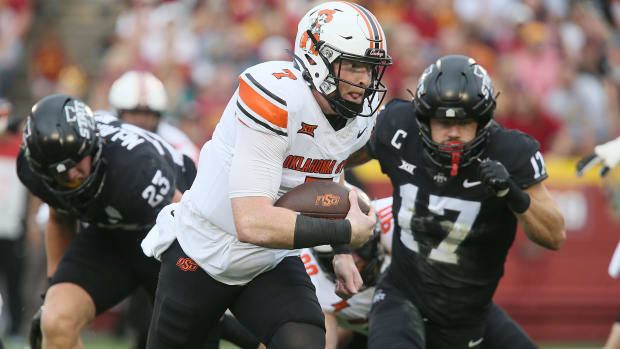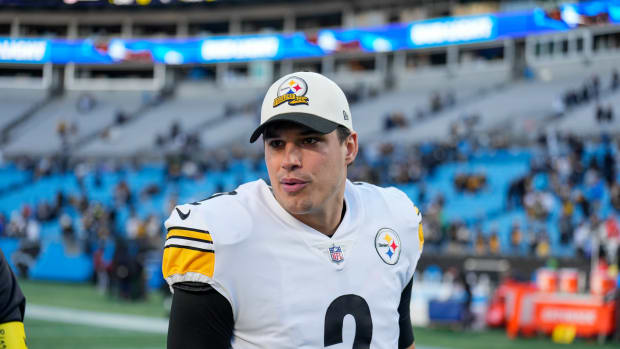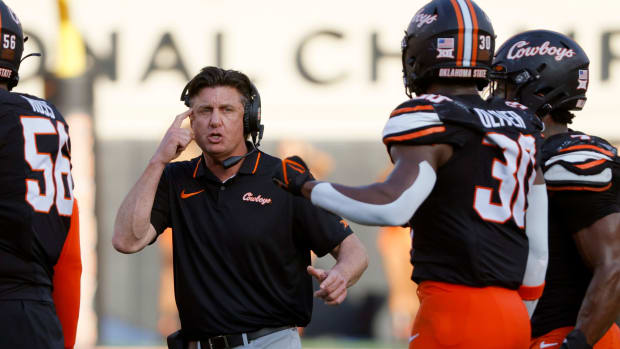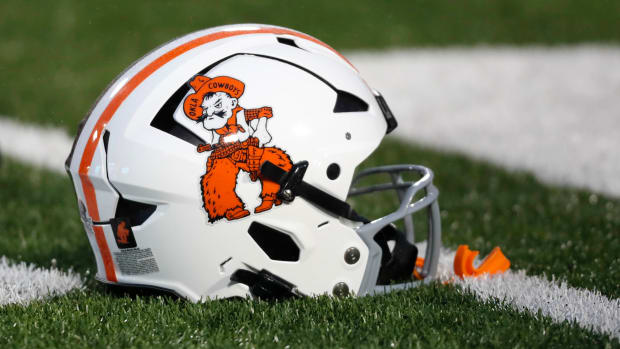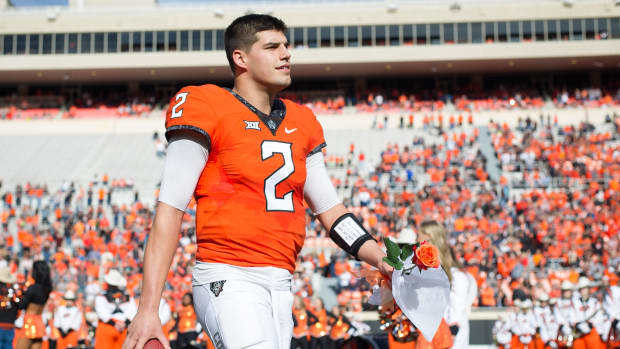High School Associations Making Workout Decisions, College Conferences Still Discussing Calendar and COVID-19
STILLWATER -- I hate that I am even writing this. The truth is that nobody knows what the truth is. That was kind of evident in the Sports Illustrated cover story on Thursday, May 14 where Ross Dellinger wrote about when college football stands in the face of the COVID-19 pandemic and reported answers received from the 11 conference commissioners SI spoke with. Media love to speculate and they do so frequently. It is the media's job to speculate. Evidence the opinion on my radio show this week from one of the most powerful people in college sports in College Football Playoff executive director Bill Hancock.
"First of all I want to go back to speculating, you have to do it or I should say you get to speculate," Hancock said. "I can't, and there is nothing to be gained from me doing it, but there is a lot of fun to be had for you doing it. So keep doing it even though no one knows what's going to happen."
When Hancock made that comment, I couldn't tell if that was encouragement or he was trying to be cryptic and deliver me a message if I went back and studied his prose.
I think what he was communicating was we need to continue to talk. The virus, the medical professionals studying and treating it, and the government officials hoping to contain or control it will make decisions. However, if we keep talking then that will keep pushing for answers or planning that can create answers.
Oklahoma State University head football coach Mike Gundy, the head coach that we cover and cover his team, was blasted when he pushed for planning way back in the first weeks of the pandemic. Okay, Gundy called the virus by another name that drew some ire. He brought in the economics and monetary concerns. However, that is obvious. College athletes, football players included, get a free education in return for using their athletic talents to represent the university. Guess what? Just like coaches, like Gundy, want to coach and writers and broadcasters, like myself, want to write or talk about the games; players want to play.
While they won't make decisions directly on the coronavirus, the collegiate conference commissioners will make decisions based on the larger ones as to when college athletes can begin team functions and workouts. They will help decide when football fall camp can begin. Remember the sports medical professionals and the football and strength staffs believe six weeks is needed to be ready to play. A couple of weeks on the front end for conditioning would be ideal.
“There is no playbook for this,” says Pac-12 commissioner Larry Scott.
However, there are other entities that are dealing with similar ramifications. NASCAR starts up this weekend. The PGA will start up in mid June. We all know Major League Baseball and the NBA are still talking but not doing much deciding. The NFL seems to be full steam ahead, but all of their normal spring and early summer activities are on hold.
Interestingly, high school associations seem to be making decisions. Oklahoma high schools will be able to start working with athletes on June 1, but there are restrictions involved.
Louisiana's high school governing body, LHSAA has pushed their date back, but will allow workouts to begin on June 8.
Meanwhile, the commisioners of the Power Five conferences in college athletics, including Bob Bowlsby of the Big 12, Greg Sanky of the SEC, Kevin Warren of the Big Ten, John Swofford of the ACC, Larry Scott of the Pac-12, and Jack Swarbrick, the athletic director of Notre Dame continue to meet on conference calls and Zoom meetings for the past two months. They also meet with the Group of Five commissioners twice a week. They have a heavy agenda, figure out how and when to play football to save college sports, their members, from a gigantic athletic recession, possibly depression.
“I would say I’m a little more optimistic today than I was two weeks ago,” Big 12 commissioner Bob Bowlsby told Sports Illustrated. “Some of that is having been on the calls with the White House. One of the things we heard is that it’s expected that testing nationally is going to double every month from now on.”
The staff at Sports Illustrated and the writer on their story, From Newfound Optimism to Potential 'Disaster': Inside the Conversation Around College Football's Return, Ross Dellinger spoke to the league commissioners and asked questions. We borrowed their questions and the answers of our conference commissioner in the Big 12, Bob Bowlsby.

Bob Bowlsby surrounded by media at a past Big 12 Football Media Days. This year's even has already been cancelled and will be held virtually.
USA Today Sports Images - Kevin Jairaj
Q: Who's going to make the decision to restart on-campus training?
Pokes Report Publisher's Note: Our sources tell us that athletic directors and school presidents will be revisiting that topic with Bob Bowlsby on Monday next week (May 18).
Bob Bowlsby (Big 12): Athletic administrators aren’t going to decide this stuff. It’s going to be university presidents empowered by their boards, and their board is typically powered by the governor and public health director. Until we get a green flag, we can do all the planning we want to, but none of it is worth the paper it’s written on until we start to see a little bit of a timeframe.
Q: When must decisions be made to begin on-campus athletic training and on whether to delay the season's start?
Bowlsby (Big 12): If we don’t start until the first of August, it is likely to delay the beginning of the football season. I think we have to see evidence that we can start practicing in earnest by the 15th of July or in that ballpark.
Q: Can you have on-campus athletic activities without students attending classes in person?
Bowlsby (Big 12): If in the main students are taking classes online, I don't think it's a problem that student-athletes take classes online and participate in athletics. However, if the university is closed and nobody is taking classes in-person or online in any way, I don't think you can have sports because these are student-athletes and they need to be enrolled and going to college to participate in the program.
Q: What if 40 states are open and 10 states are closed? Do you start playing football without the schools in the 10 closed states?
Bowlsby (Big 12): I think you probably start playing. That could actually happen within leagues as well. It’s almost a more difficult question within leagues than on a national basis. There are places that are hotspots. The numbers in Dallas are continuing to climb. Our governor [in Texas] has proclaimed we’re going to start opening up business and society and he even acknowledges that there is a bit of a gamble with it and that they’ll have to watch it carefully. We’re going to have to watch it, too. We go back to practice and all a sudden we have somebody test positive, we’re going to be out of business.
Q: During the season, if/when someone test positive for COVID-19, what happens?
Bowlsby (Big 12): This virus isn’t going away. It’s like chicken pox or HIV or SARS or MERS. You learn how to co-exist with it and mitigate the severity with a vaccine. We’re going to have to find the new normal and like we did after 9/11: air travel changed forever. There are going to be components of this that will change forever.
Q: Will fans be allowed to attend, and if so, who gets the tickets?
Bowlsby (Big 12): I think the most fascinating part of it for me is pondering the psychology of it all. Are people, even good sports fans, going to want to go in and sit cheek by jowl with people they don’t know in a traditional stadium setting? You could certainly see a stadium that goes from having an 80,000 capacity to having a 20,000 capacity in order to get the necessary separation. There was a survey from Seton Hall saying 72% of the people they surveyed wouldn’t go back to public assembly events until there is a vaccine. You could be a really big fan, but if you had some underlying health issues, I don’t know that you want to risk going into a stadium.
Q: If you have a shortened season, do you just play conference games only?
Bowlsby (Big 12): To get a viable season that would lead to some sort of appropriate postseason, seems like you got to get half of the year in or something approaching that. If we had to start the season after the middle of October, I guess at that point we’d be thinking about doing a split season or moving to a spring season.
Q: If a season can't be played in the fall, can it be played in the spring?
Bowlsby (Big 12): I don’t see us preemptively moving to a spring season, partly because we don’t know that it would be any safer or better than doing it in the fall. I could see us getting forced into it at some point in time or get some sort of split season.
Again, no answers definite answers and the clock is ticking.

